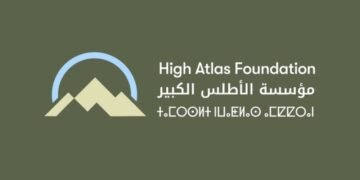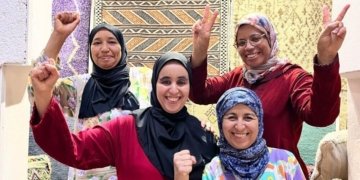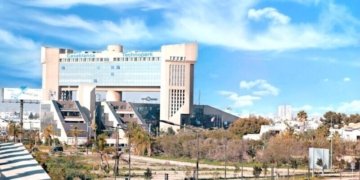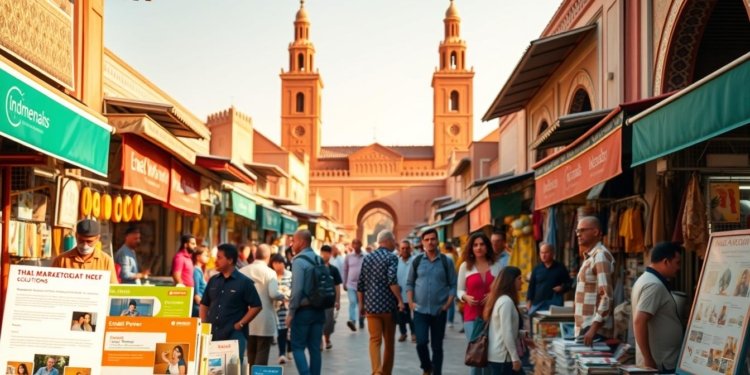Did you know that a rare cancer affecting the digestive system could hold the key to unlocking powerful email marketing strategies? Gastrointestinal stromal tumors (GISTs) might seem unrelated to digital campaigns, but their targeted nature offers valuable lessons for Moroccan businesses.
GISTs are soft tissue sarcomas that develop in the gastrointestinal tract, most commonly in the stomach. Like these rare growths, successful email marketing requires precise targeting and early detection of opportunities.
In Morocco, where digital adoption grows rapidly, understanding these parallels can transform your campaigns. The same way GISTs respond best to early intervention, email marketing delivers optimal results when deployed strategically from the start.
Key Takeaways
- GISTs are rare cancers primarily affecting the digestive system walls
- Stomach location accounts for 60-70% of cases in Morocco
- These tumors originate from specific cells in the gastrointestinal tract
- Most commonly diagnosed in males aged 60-65
- Early detection significantly improves outcomes
What Is a Gastrointestinal Stromal Tumor (GIST)?
Unlike common digestive issues, GISTs originate from unique cells controlling gut movement. These rare tumors develop in the digestive tract, most often in the stomach or small intestine.
Definition and Key Characteristics
GISTs are a type of sarcoma, forming in stromal tissue. They arise from interstitial cells of Cajal, which regulate digestion. Over 95% test positive for the CD117 protein, a key diagnostic marker.
Genetic mutations, especially in the c-kit gene, drive 85% of cases. Early detection improves outcomes, as these tumors can spread to the liver or abdomen.
Where GISTs Develop in the Body
In Morocco, 70% of GISTs occur in the stomach. Another 20% grow in the small intestine. Rare cases affect the esophagus or colon.
A Casablanca oncology study found unique metastasis patterns in regional patients. Compared to other abdominal tumors, GISTs often require targeted therapies.
Symptoms of GIST: When to Seek Medical Help
Early-stage GISTs rarely cause symptoms, making timely diagnosis challenging for Moroccan patients. About 20% show no signs until the tumor grows or spreads. Recognizing subtle changes can save lives.
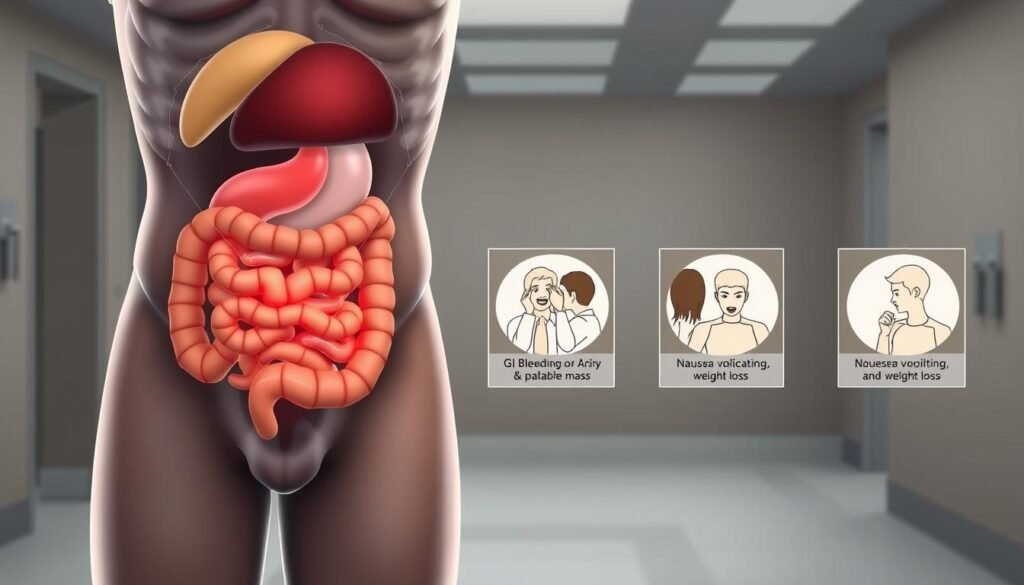
Early-Stage vs. Advanced Symptoms
Early signs are often mistaken for indigestion. Mild abdominal pain or fullness after meals are common. Some people report nausea or unintended weight loss.
Advanced cases present severe symptoms. Hematemesis (blood in vomit) or melena (dark, tarry stools) indicate bleeding tumors. Obstruction or rupture causes sharp pain and requires emergency care.
Common Misdiagnoses and Red Flags
In Morocco, GISTs are frequently confused with peptic ulcers or IBS. Doctors may overlook the condition without proper imaging. Persistent symptoms despite treatment should raise alarms.
A Rabat patient shared: “My ‘ulcer pain’ lasted months before scans revealed the tumor.” Blood tests showing anemia can also hint at hidden bleeding.
Act fast if you notice:
- Unexplained fatigue (from blood loss)
- Swelling or lumps in the abdomen
- Sudden, severe pain
Diagnosing GIST: Tests and Procedures
Modern diagnostic tools like endoscopic ultrasound pinpoint tumors with 90% accuracy. Moroccan clinics combine imaging and lab tests to confirm suspicions and guide treatment.
Endoscopic Ultrasound and Biopsy
An endoscopic ultrasound visualizes tumors in the stomach or intestines. A biopsy collects tissues using a core needle, minimizing risks.
In Morocco, public hospitals in Casablanca and Rabat offer this procedure. Private clinics in Tangier provide faster results for a higher fee.
Protein Testing (CD117 and c-kit Gene)
Over 95% of GISTs test positive for the CD117 protein. Labs in Tangier check for c-kit gene mutations to confirm diagnoses.
Results determine if targeted therapies will work. Delays in testing can impact survival rates, so prompt action is critical.
Treatment Options for GIST
Effective management of rare abdominal tumors requires personalized treatment plans. Moroccan oncology teams combine surgical expertise with advanced medications for optimal results. The approach depends on tumor size, location, and genetic markers.

Surgery: Removing the Tumor and Margins
The Marrakech Cancer Center specializes in minimally invasive procedures for small tumors. Surgeons aim to remove the mass with clear margins, crucial for preventing recurrence.
For tumors under 2cm, laparoscopic methods reduce recovery time. Larger growths may require open surgery. Patients typically stay 5-7 days for post-operative monitoring.
Targeted Drug Therapies (TKIs Like Imatinib)
When surgery isn’t enough, tyrosine kinase inhibitors (TKIs) become vital. Imatinib, taken for 3 years post-op, cuts recurrence risk by 40%.
Morocco’s medication access programs help patients afford these drugs. Doctors monitor for side effects like fatigue, especially in hot climates.
When Surgery Isn’t an Option
For advanced cases, sunitinib provides 6-12 months survival benefit. Palliative care teams focus on pain management and quality of life.
Regular scans track treatment response. Moroccan hospitals use cost-effective sequences to maximize health outcomes.
Coping with a GIST Diagnosis
Receiving a GIST diagnosis can feel overwhelming, but knowing where to find support makes a difference. Moroccan patients have access to specialized resources for this rare condition. With proper management, many maintain good quality of life.
Finding the Right Support Networks
Local groups in Casablanca and Fes connect patients facing similar challenges. These communities share practical information and emotional encouragement.
GIST Support UK extends assistance to international patients, including Arabic speakers. Many people find comfort in discussing treatment experiences with others who understand.
Psychological services in both French and Arabic help process the emotional impact. Hospitals often provide counselor referrals during treatment planning.
Sustaining Health Over Time
Nutrition plays a key role after stomach surgeries. Dietitians adapt traditional Moroccan dishes to meet post-gastrectomy needs.
Regular exercise helps manage TKI therapy side effects. Light walking and swimming are often recommended during treatment.
Doctors schedule imaging scans periodically to check if tumors come back. High-risk cases require closer monitoring over time.
Financial aid programs help cover medication costs. Many Moroccan hospitals assist with paperwork for these services.
Conclusion: Key Takeaways on GIST
Recognizing GIST early improves outcomes. Moroccan doctors should watch for persistent abdominal pain or unexplained weight loss. These signs often get overlooked.
Treatment works best with a team approach. Surgeons, oncologists, and nutritionists collaborate for better results. Public hospitals now offer targeted drugs like imatinib.
Always consider a second opinion. Specialized centers in Casablanca provide advanced diagnosis tools. Early screening helps catch tumors before they spread.
Report unusual symptoms promptly. Participating in Morocco’s cancer registry aids research. Together, we can improve care for this rare condition.
FAQ
What is a gastrointestinal stromal tumor (GIST)?
A GIST is a rare type of cancer that forms in the digestive tract, usually in the stomach or small intestine. It develops from special cells called interstitial cells of Cajal.
What are the common symptoms of GIST?
Symptoms may include stomach pain, nausea, vomiting, blood in stool, or feeling full quickly. Some people show no signs until the tumor grows large.
How is GIST diagnosed?
Doctors use imaging tests like CT scans, endoscopic ultrasounds, and biopsies. They also test for specific proteins (CD117) or gene mutations (c-kit).
What treatment options are available?
Surgery is the main treatment for removable tumors. Targeted drugs like imatinib (Gleevec) help shrink or control growth when surgery isn’t possible.
Can GIST come back after treatment?
Yes, recurrence is possible. Regular follow-ups with scans and blood tests help detect any return early for prompt management.
Are there support groups for GIST patients?
Yes, organizations like the Life Raft Group provide resources, research updates, and communities for patients and caregivers.
What long-term side effects might treatment cause?
Fatigue, nausea, or muscle pain are common with targeted therapies. Surgeons monitor for digestive changes if part of the stomach or intestine is removed.





